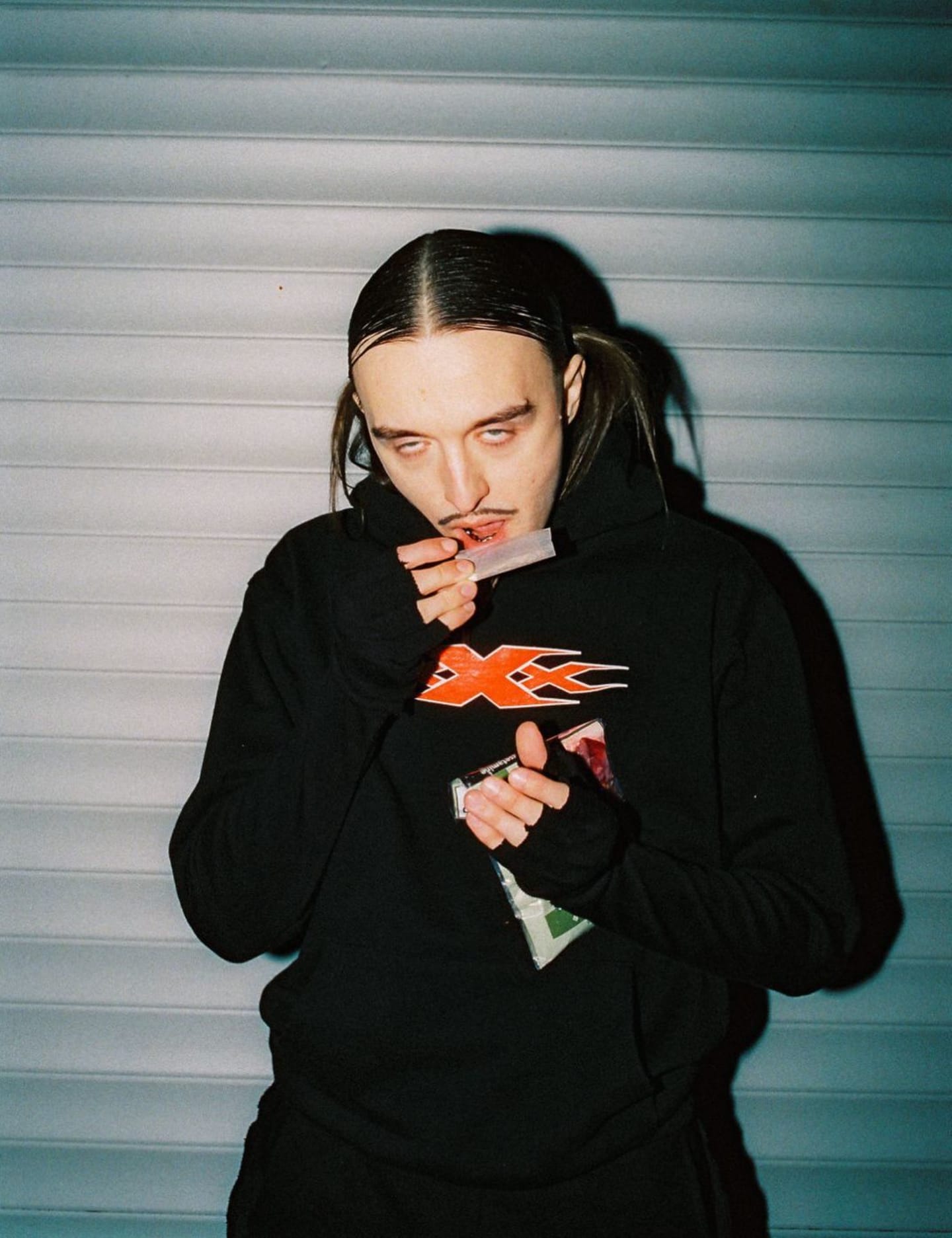
Tommy Cash is always in his rave era
The self-proclaimed “most famous Estonian in the world” shares his thoughts about digital Situationism, dancing peasants and what it means to have Eurodance in your bloodstream.
In attempting to identify the Estonian rapper, conceptual artist and anti-fashion icon Tommy Cash’s role in the pop cultural landscape, a historical figure comes to mind: the court jester. While the stereotype conjures images of a juggler in a ridiculous outfit, jesters in the Middle Ages held places of significance in royal courts and high society. They were entertainers who sang, danced, told stories and pulled pranks, but they also were observers with quick wit, who were bestowed with a unique privilege to mock and critique both people and systems of high rank and importance. Cash has carved out a similarly rare place for himself among the most elite and exclusive circles of pop music and luxury fashion, by being accepted and appreciated by the very people and system that his art is challenging.
Even if you haven’t heard Tommy Cash’s discography–which fuses the hardcore sounds of 90s electronic music with a tongue-in-cheek, Eastern European take on American trap–or seen him perform live, you have likely seen some of Cash’s antics on your newsfeed. Perhaps you’ve encountered a video of walking a pair of drones on leashes as if they were dogs, riding on the back of a moped in Paris wearing nothing but a long wig, chasing celebrities while pretending to be a member of the paparazzi, or working on two laptops, two iPhones and an iPad, simultaneously, while sitting front row at a fashion show. Be it in songs, music videos or performances, Cash masterfully manifests his own surrealist visions, engineering uncanny situations that comment on some of the defining topics of our time: the decaying construct of gender, the alienation of digital life and the superficiality of our values under hyper-capitalism. With cosigns from designers like Rick Owens and John Galliano, and electronic music legends like AG Cook (of PC Music), Amnesia Scanner and Charli XCX, Cash is the living and breathing embodiment of the jester’s privilege–and has established himself as one of the most unique provocateurs working in the creative industries today. Following his performance at Sonar Lisbon, the (self-proclaimed) “most famous Estonian in the world” shared his thoughts about digital Situationism, dancing peasants and what it means to have Eurodance in your bloodstream.

You’ve mentioned in past interviews how much you love performing–I’m assuming a big part of that has to do with your love of dancing. Growing up, was your interest in breakdancing born from the internet, films or nightlife?
My interest in dancing was born from a couple of people in my grade at school. We started going to dance class, but as I went along, I found that I hated choreography. I couldn’t follow anymore–I didn’t want to. But I had a nice teacher who basically said: “Move how you feel, do what’s inside of you.” So it stopped quickly, in the class sense, but I continued by self-learning. I went to the gym every day and would dance in front of the mirror. I was inspired by some dancers that I loved and, just by practicing every day, figured out what style I wanted to do. I eventually started battling with other b-boys and learning more tricks. But I would say I am 85% self-taught.
But I think, when you dance, it’s mostly out of fear [laughs]. When you dance, you’re like a peasant. You’re just the guy who stands in front of the castle, protecting people from entering. I remember I was doing backup dancing for someone and I felt like: “this is wrong, I should be the one in the front.” When you’re a performer and able to fuse dancing with your own music, then you’re like a samurai. It’s a level up.
As an artist working in many mediums, are stages like the ones at Sonar simply another kind of canvas for you? What aspects of your artistry do platforms and crowds like these allow you to unleash, that maybe you can’t in other forms?
Being on stage with your own music is the basis of everything, it’s where it all starts from. If people stream your music or see how you look on the internet, that’s one thing. But all of my biggest inspirations as a musician, like Hendricks and Morrison, were great performers. Performing is a blank canvas, it’s freedom of expression. The other things I do are more like fashion terrorism. That’s closer to performance art. When people come to see me at my shows, it’s the most primal form of expression–because performing on stage is like miming who I am. Performing also allows you to access a weird, maximum energy level that you can’t access in other forms. As I continue with my sets, eventually the mosh pits open up and you become one with the people. It’s a beautiful feeling.
To me, your social media presence feels like digital Situationism–does the Situationist art movement and its philosophy resonate with you and what you do?
To be honest, I had to google what that meant! But if I understand correctly, it’s essentially the idea that people are driven by situations, not by human behavior. You know…I’m not analytical like that. I do whatever the fuck I want. I do what I want to do, and make what I want to see – what I think is fun for me and the people around me. It’s as easy as that. You can see that I go from A to D very quickly. I’m not sticking to some kind of pattern. If we like something, we do it. And hopefully tomorrow, we do something new, because I’m all for innovation.

“Shocking” is, of course, a huge buzzword around your career and work. But in the years since you have been in the spotlight, people have only become more entrenched in the digital universe. Do you think this affects our ability to be shocked? And do you the internet increases or decreases shock’s effectiveness as an artistic tool?
Yes, people love to use the word “shock” around me and have for all of the years that I have been doing my thing. But if people want to label me as a shock artist, I would label most other artists as boring. I think the internet does have a numbing quality to it. It’s too much of the same thing. I label myself as an adrenaline junkie, and by doing things that I don’t see other people doing, I feel good–and it goes from there. As the years go by, the internet is becoming more and more controlled. Soon it will be that you can’t show your knee, or something like that. Meta and TikTok are becoming dumber, in that sense–they’re taking down stuff that is not inappropriate in any way. I wish the internet would become freer, it’s all super PG13 right now. The algorithm is not for me, they don’t push [my content], but I think people are still for it. I think we all just want to be moved, either by love, hate, or disgust… these are the things that drive us.
What was the last thing that really shocked you?
My threshold is so high, I’m not sure if “shock” has the same meaning for me. The last thing that “shocked” me was probably the Maison Margiela show. It was so truly beautiful. The clothes, the music, the environment, the vibe… it was so well put together, I actually had tears in my eyes. I haven’t felt like that before. Another thing is the Marilyn Manson book that I read recently. There’s some really gruesome stuff in there. Even just the way it’s written is really… out there.
You’ve mentioned the role of Eurodance and trance in your musical coming of age, and there are a lot of references to early techno music in many of your tracks. Has nightlife played a big role in your life?
I’m from Eastern Europe, so Eurodance flows through my bloodstream. I’ve definitely been involved in raves at one point in my life–I think I’m always in my rave era! I’ve also been to those famous witch house parties [VV17CHOU7] in Moscow in 2012, 2013 and 2014. I had one of my first gigs there.
Have you noticed nostalgic rave sounds becoming more prevalent in music lately, and if yes, why do you think they are becoming so popular right now?
There are a couple of ways to think about nostalgic sounds. It’s kind of a joke– it’s all a remake of a remake, and a reboot of a reboot. We do this in movies and art. Stranger Things is a great example. It’s just one big pot of nostalgia and people are eating it up. Big machines–like cinema groups–see that it works, and think: “we can sell that.” Naturally, there are also a lot of tracks that have this big bass sound, and that works as well. I think people just want to get away more. Nostalgia is one way to do that, and this *unce unce* world is another. I think a lot of people are discovering this right now. I’m not sure if Beyonce had a gabber track on her dance album, but if she didn’t I am sure she will release one soon.
Images by Pedro Loete, Shot at Sonar Lisbon backstage
Written by Cassidy George
Published July 10, 2024.
